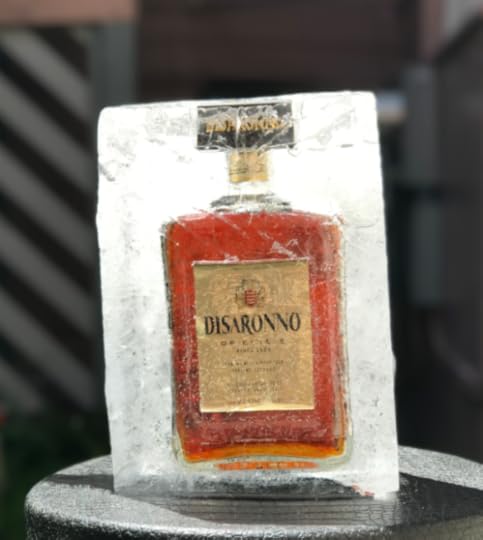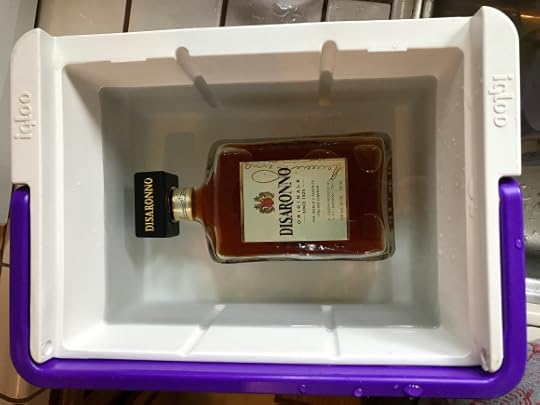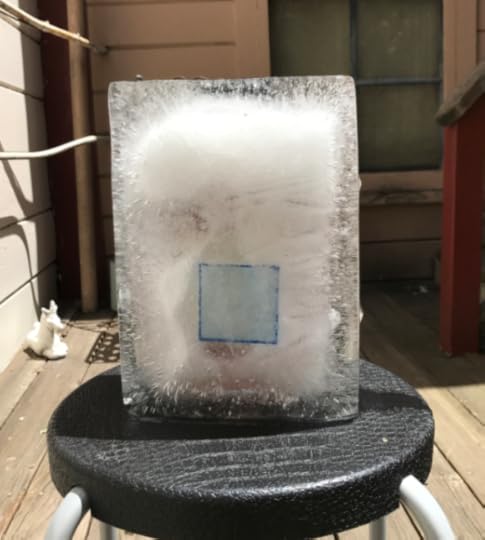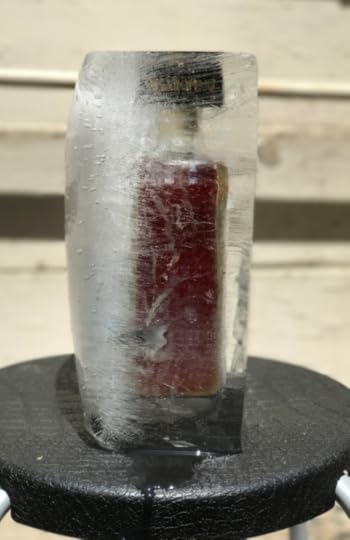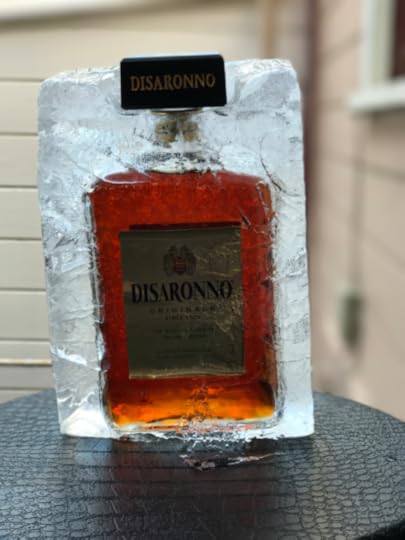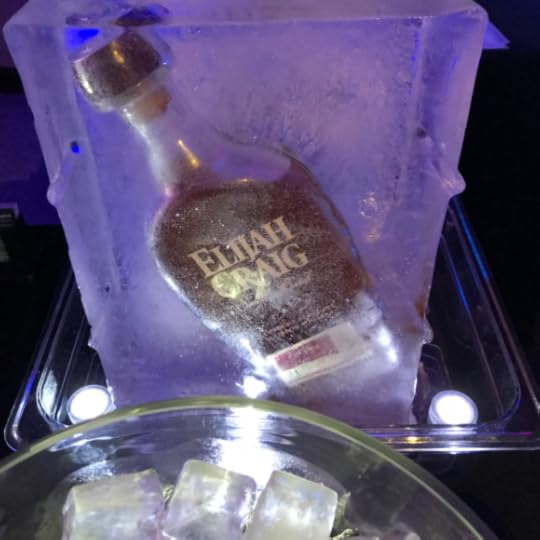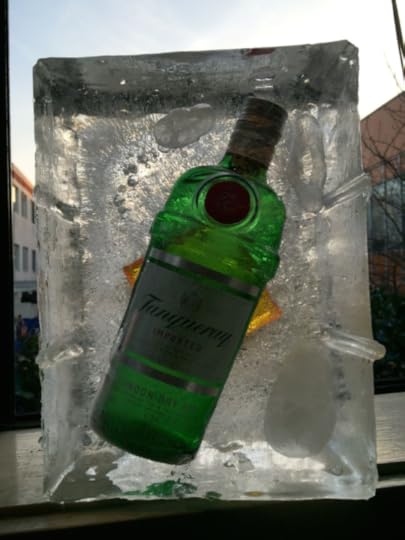Camper English's Blog, page 62
July 15, 2017
Campari is Made Differently Around the World: Cochineal, Coloring, ABV, & Eggs
 I was researching a few different topics and stumbled upon an interesting observation: Not only is Campari sold at a wide-ranging variation of alcohol percentage in different countries, the coloring used to make its signature red is different depending on the country.
I was researching a few different topics and stumbled upon an interesting observation: Not only is Campari sold at a wide-ranging variation of alcohol percentage in different countries, the coloring used to make its signature red is different depending on the country.
As many people know, Campari was traditionally colored with cochineal, a scale insect native to South America that grows on the prickly pear cactus. (Cochineal is still used in many products today, as it is a natural coloring and doesn't need to be labelled as the unsightly 'artificial coloring'.)
In 2006 cochineal was discontinued - but as it turns out, not everywhere. In the United States and it seems most countries, Campari now uses artificial coloring. Depending on which country one is located in, that coloring must be declared in different ways, so what is merely "artificially colored" in the US is labelled as three specific coloring agents in one country, and none at all in others.
But in at least one country, cochineal is still used.
In the United States, Campari is sold at 24% ABV and the coloring is listed as "artificially colored."
In France, the ABV is 25% and the colorings are listed as E122, E102, and E133.
It appears it is the same in Argentina (with INS instead of E numbers), but the proof is 28.5%.
In Toronto, it is sold at 25% and the color is merely misspelled (kidding!) as "colour."
In Australia, it is sold at 25% with no special color labelling.
In Iceland, it's sold at 21% ABV with no special color labelling.
Now here's where it gets really interesting.
I was wondering if the Swedish government website was merely out of date as it lists the coloring as E120 - that's cochineal(!), but a friend just picked up a bottle recently and cochineal is still in Campari. Additionally, it is sold at 21% ABV.
And even more bizarrely is this bottle of Campari from Jamaica. Hold onto your butts:
"Blended and bottled in Jamaica... by J Wray & Nephew" [Campari now owns JW&N]
28.5% ABV
"Contains Egg"
CONTAINS EGG. Folks, that is some interesting news right there. Typically when eggs are used in wine, beer, and spirits (that aren't egg-based liqueurs), the eggs have been used in the fining process that helps filter the products to clarity. I think it's fair to assume this is how eggs are used in Campari.
My guess would be that because Jamaica has a Rastafarian community, many of which are vegans, products fined with eggs are required to be labelled.
What this means though, is that even though they took out the cochineal insect coloring (except in Sweden apparently), Campari, at least in Jamaica, is still not vegan.
The question remains what it is in the rest of the world.
Keep in mind that much cane sugar is whitened using bone charcoal, so any liqueur or sweetened alcohol has an okay chance of being non-vegan.
Thank you to my Facebook friends from around the world who shared their bottle images. If you live in another country not mentioned here, please send me your bottle image to add to this discussion. Thanks!
P.S. I'm writing a book on Bugs & Booze. Want to be notified when it launches? Join my forthcoming email list and I'll let you know!

July 10, 2017
Pabu's Cocktail Program Now One of the San Francisco's Best
The other week I had a chance to check out the seasonal cocktail menu at Pabu, the huge and fancy Japanese izakaya/sushi restaurant from the Michael Mina Group in the Financial District of San Francisco. I've been to Pabu on several occasions, and the drinks have always been good, but I think they're now at the top of their game.
The cocktails are the increasingly-rare combination of inventive, savory, light, and refined; and a refreshing deviation from what most other bars in the city are doing.

Hana cocktail, all images courtesy of Pabu.
Lead Bartender Nick Jones says the new drinks are the result of a team effort, and they also have a leg-up from Alameda's St. George Spirits: many of the cocktails include their take on funky shochu (that I didn't even know they made). Ingredients like St. George's fantastic Baller whiskey, the light Suntory Toki whisky, junmai sake, and pickled plum, add unfamiliar, interesting flavors and keep the menu on a tightly-controlled Japanese theme.
About half the menu changed over recently. Below are the new drinks.
Sumo, a bold whisky drink served in a ceramic mug with a dominant note of sesame oil. Despite the tangerine and basil flavors, I'd choose this drink as a digestif. It doesn't so much go with food; it is food.

Sumo.
Hana, an elegant, soft and savory aperitif cocktail of sake and Suze, served from a teapot. (image above)
Murasaki, a bright and refreshing cocktail that's equal parts tequila and shochu in flavor; a fantastic introduction to what this menu is all about.

Murasaki
Baller, a Manhattan-style cocktail with St. George Spirits' Baller whiskey and Byrrh; probably one of my favorite drinks in San Francisco at the moment.
Hadouken, which reads on the menu like another stupid boozy mezcal-and-bitters drink with Amaro Montenegro and Union Mezcal, but is in format wonderfully, surprisingly light-bodied and probably quite izakaya-food-friendly.

Hadouken
Geisha (they really need better names for these drinks), a drink with rum, sake, strawberry, and Chartreuse cream that is the showdrink (I think I'm going to start using this term from now on) to order for people nervous about the menu, in that it's tasty but also has the friendly-foamy-yum factor.

Geisha
The second page of cocktails includes held over from previous menus. I tried one I'd missed previously: the Shiso Delightful with St. George shochu, shiso-infused vermouth, sherry, lemon oil, and bitters. It was huge in funky, grassy, what-the-eff flavor (probably too huge for some people) and the drink to try if you love big drinks, rhum agricole, and/or want a final-final drink of the night. It's three weeks later and I think I can still taste it.
The drinks range from $13 to $16 so you're definitely paying for the unique and pricey base spirits in the cocktails, but thirteen dollar drinks in SF is no longer shocking. Treat yourself.

July 7, 2017
The Impact of Phylloxera on Absinthe
 I'm giving a talk at Tales of the Cocktail on "Bugs and Booze," and in reading up on the vine-killing aphid phylloxera, I came across a point of history I didn't understand.
I'm giving a talk at Tales of the Cocktail on "Bugs and Booze," and in reading up on the vine-killing aphid phylloxera, I came across a point of history I didn't understand.
Phylloxera devastated the French (and eventually the world's) wine industry from the 1860s to around 1900. Most absinthe was made with a base of brandy- distilled wine- so it too should have been affected by phylloxera and been less available.
But if that was the case, then why did absinthe sales supposedly soar during phylloxera, and why did the wine industry feel the need to launch a negative PR campaign against drinking absinthe when it recovered? (This PR campaign was successful in getting absinthe banned in France and other countries for nearly 100 years.)
So I posted a question to my smart friends on Facebook:
Absinthe nerds: We always hear that post-phylloxera the recovering wine industry did a negative PR campaign on absinthe so that wine could resume its place on the throne. But wasn't most absinthe originally made with a wine/brandy base? When did it switch to a grain base (if it really did) - during or previous to phylloxera? Does anyone have historical data on this?
Well, many, many comments later, I have some ideas about the impact on absinthe, thanks to experts including Anna Louise Marquis, Joshua Lucas, Brandon Cummins, Gwydion Stone, Jack Crispin Cane, Fernando Castellon, Stephen Gould, Francois Monti, Ted Breaux, Heather Greene, Brian Robinson, Alan Moss, and others!
I'll break down my understanding of it. You'll note that I'm not citing any sources here so it's up to you to fact-check, but this is what I got from listening to absinthe history experts:
The Base Spirit of Absinthe Changed Due to Phylloxera
Absinthe can be made with any base spirit. Legal regulations were proposed in France that certain quality marques of absinthe (such as "Absinthe Superieure") need to contain grape distillate as the base, but these were never put into law as far as I know. (One source said the wine lobby actually worked to block any quality markers for absinthe.)
Not all absinthes were made with a grape-based distillate (but marc/grape was considered the best); and absinthe in general had a problem with low-quality (or even poisonous) brands with additives masquerading as the good stuff.
Sugar beet spirit became a predominant base spirit not only in absinthe, but in most French liqueurs. This is due only in part to the absence of grape spirit during phylloxera: Napoleon had launched a massive campaign to plant sugar beets in France to be more self-reliant. From a post I wrote in my project studying sugar: "Napoleon, due to the economic and real war with England, bet big on sugar beets. In 1811 he supported vast increase in sugar beet production. Within 2 years they built 334 factories and produced 35,000 tons of sugar."
Additionally, column distillation came along in the 1830s, which made it easier to get a high-proof, nearly-neutral spirit from most any base material. So in addition to sugar beets, things like potatoes and grain were used as a base for absinthe.
So there were many reasons that the base of most absinthes changed to sugar beet or grain during phylloxera. Pernod Absinthe's quality selling point was that it never changed its base.
Sales of Absinthe Soared in the Age of Phylloxera
True, from pretty much all accounts. Sales of absinthe were increasing before phylloxera, but absinthe's low price and wide availability during the crisis further helped sales. Then after absinthe was banned, sales obviously dropped a bit. So the 30 year period of phylloxera in France coincided with the glory days of absinthe. This is the heart of the Belle Epoque 1871-1914.
Absinthe was Banned Due to the Wine Industry Running a Negative PR Campaign
Anti-absinthe propaganda began before phylloxera did, promoted by a Temperance movement. Much like in the US, distilled spirits were considered the problem with drinking, while beer and wine were considered healthy. (Francois Monti says that beer/wine were considered 'natural' while spirits were 'artificial'.) So the anti-absinthe movement was already in motion pre-phylloxera.
But certainly the low-quality (and low-priced) absinthes on the market, which surely became of even lower quality during phylloxera when there was less wine to go around, were a problem, and gave anyone who was opposed to absinthe a target. As some people commented, now even the lower classes were drinking absinthe, for shame!
When the wine industry recovered fully or in part, they wanted all their sales back so they engaged in/funded negative PR campaigns about how dangerous absinthe was. These campaigns helped get absinthe banned after 1900 in many parts of the world.
Well, that's a short version of a very long and interesting discussion. I hope I've done it justice.

July 5, 2017
Smooth and Mellow Vodka Drinks from 1967
My friend gifted me a 1967 "Friendly Host" calendar from a liquor store in upstate New York. On the backs of the calendar months are helpful advice for cocktailing and hosting.
The dates from 1967 align with this year, though the drinks are a little bit different to what we enjoy now.... or are they? (Yeah, for the most part they are.)
This page is for Smooth and Mellow Vodka Drinks. They include a Moscow Mule (as well as a Vodka Cup with is the same thing), a Screwdriver, and other super simple cocktails.

July 3, 2017
Camper English: Journalist, Speaker, Influencer, or Whatever
 I recently had to fill out my occupation on a form and put "journalist," which is only accurate in that all my work comes from the idea that I'm a journalist, but inaccurate in that I don't really do all that much journalism these days outside of some posts here on Alcademics.
I recently had to fill out my occupation on a form and put "journalist," which is only accurate in that all my work comes from the idea that I'm a journalist, but inaccurate in that I don't really do all that much journalism these days outside of some posts here on Alcademics.
Lately I spend a lot of time researching talk subjects, giving talks, judging cocktail competitions, doing brand consulting, and making drinks at special events for the tech crowd of SF.
My social media accounts have become kind of a thing where I share interesting stories and topics (Twitter) and images of new products and books (Instagram), so in that sense I get to be an 'influencer.' And lately I get quoted a lot in stories that other journalists are writing, mostly about cocktail safety, ice, and tonic water.
For sure all that other work comes because of all the journalism I've done in the past, but as journalism is the lowest-paying thing one can do, I tend towards other work when possible. I really need to write some more books so I can simply be 'author' because that's forever, while journalism is an ongoing occupation.
This isn't something that bothers or upsets me; I just realized I'm not so much of a journalist anymore but I don't really know what I am. Influencer? Educator? Just plain fabulous?
I might stick with 'journalist' for now.

June 28, 2017
Carrot Eau de Vie is Hopping Up on Cocktail Menus
In the last week or two I've seen several different cocktails on bar menus with carrot eau de vie. As far as I know, the one people are using (not that there are that many other carrot eau de vies in the world) is made by Austrian brand Reisetbauer - and a quick online search has it coming up at around $75 for a 375ml bottle. (There is a domestic one called C-Spirit I just read about as well, and St. George Spirits has made one in the past.)
At aRoqa in Chelsea, NYC, "Cachaca-based In My Garden delivers on its promise with Reisetbauer Carrot Eau de Vie, English pea puree, rhubarb, saffron and habanero."

In the Garden at aRoqa. Photo by Evan Sung.
At Lazy Bear in San Francisco, Nicolas Torres makes the "Root of it All (The Daisy) with rye, carrot eau de vie, cilantro, lemon, ginger, honey and soda."
Death & Co. also has a drink on their menu with sherry, aquavit, and carrot eau de vie. The recipe is online at Punch.

June 26, 2017
Make Amazing Frozen Liquor Bottle Displays using Directional Freezing
Using just a cooler, a makeshift stand, and a bottle you can make cool-looking displays for home, parties, or the bar.
If you're just getting started into ice nerditry, you'll want to check out the Index of Ice Experiments, where you can get a definition of Directional Freezing and see other fun projects.
I previously shared how to do this on this post.
In short: inside an insulated cooler, lay a bottle atop a small riser of some sort (I used a plastic box lid) so that the bottle is raised up a few inches off the bottom.
Fill the cooler with water (tap water is fine) so that it covers the bottle. Leave the top off the cooler and let it freeze. In my home freezer, that takes 3-4 days. Thanks to Directional Freezing, the top part of the cooler (so the front part of the bottle) will be clear, while the bottom (back of the bottle) will have all the cloudiness in it.
You can see from this back view that the plastic riser is still stuck in the back. From the side view, you can see that thanks to directional freezing the top part of the block is super clear (so you can see the front of the bottle), while the back is cloudy. It turns out the cloudy part actually makes a nice backdrop.
Remove it from the cooler than your display is ready to go. I've done this at parties (putting some LED candles in the ice beneath the standing block) and it was a huge hit.
Check out all the ice experiments on Alcademics at this link.

New RumChata Creamer Pitcher Program Helps Pour On The Profits [sponsored]
 The award-winning RumChata continues to please both consumers and trade customers with the introduction of its RumChata Creamer Pitcher program. The 2oz. RumChata branded ceramic creamer pitcher is available nationally to help drive sales and profits for restaurants by offering RumChata as an after-dinner coffee creamer.
The award-winning RumChata continues to please both consumers and trade customers with the introduction of its RumChata Creamer Pitcher program. The 2oz. RumChata branded ceramic creamer pitcher is available nationally to help drive sales and profits for restaurants by offering RumChata as an after-dinner coffee creamer.
While delicious on its own and as a mixer in thousands of cocktails, one of the most popular ways consumers enjoy the one-of-a–kind flavor of RumChata is simply mixed in their favorite coffee, espresso, cappuccino or mocha.
“The RumChata Creamer Pitcher program is the perfect upsell for after-dinner drink menus at all restaurants, from casual to white table cloth,” said Tom Maas, RumChata founder and master blender. “Based on our research, promoting RumChata as a coffee creamer to patrons can turn a five-dollar cup of coffee into a ten-dollar cup of coffee for the account.”
RumChata is available in all 50 states. More about RumChata including food and drink recipes and where it is available can be found at www.rumchata.com, on the RumChata Facebook page and on the RumChata app, which can be downloaded on iTunes or the Google Play Store.
This post is sponsored by RumChata.

June 22, 2017
Freeze Liquor Bottles Inside an Ice Tube for Better Bottle Service
Using just a cooler, a tube, and a bottle you can a super funky display for your party or for bottle service at your bar.
If you're just getting started into ice nerd stuff, you'll want to check out the Index of Ice Experiments, where you can get a definition of Directional Freezing to see why this works, and see other fun projects.
I originally developed this technique for the bar Whitechapel, which was looking to do a unique Martini cart with frozen bottles.
Simply put a bottle inside a tube of some sort (this is a metal utensil holder like you'd see at a salad bar) and fill both the tube and the rest of the cooler with water. Directional Freezing will take care of making the top part of the ice clear. The cloudy part is all around the bottom of the bottle. If you wanted it 100% clear around the bottle, you'd simply put it on a short riser inside the tube.
Then freeze it (with the top off the cooler) and pull it out.
I did this again with a bottle Zucca as I'm using it for a talk. I no longer had the metal utensil container so I put in a plastic pitcher. I wouldn't say it is the ideal container given that is has irregular sides, but it did the trick for proof of concept.
The bottle is a bit problematically tall for my freezer - I almost couldn't get the cooler out!
Cheers!
Check out all the ice experiments on Alcademics at this link.

June 20, 2017
Freezing Mini Bottles Inside Collins Ice Cube Spears
Party Trick! Using an insulated cooler and some gift boxes, you can make super clear tall collins glass ice spears with mini bottles frozen inside them.
If you're new to Directional Freezing, check out the Index of Ice Experiments where it is explained.
I bought plastic gift boxes from The Container Store to make tall ice spears a while back. Check out that post here. Note that for commercial purposes, these gift boxes aren't certified food safe, so I wouldn't go trying to scale up a bar program with them. (They're also hard plastic and crack easily.)
More recently, I decided to freeze some Disaronno minis inside of them for an event. They came out adorably awesome.
Simply fill the cooler with gift boxes and the gift boxes with minis. Fill the cooler (both inside the gift boxes and outside around it) with water. Let it freeze into a block.
Then with a great deal of patience, separate out each of the boxes and turn them over so that the cubes slide out. Fun times.
Maybe I should have actually put one inside a collins glass so you could see how it looks.
Check out all the ice experiments on Alcademics at this link.














